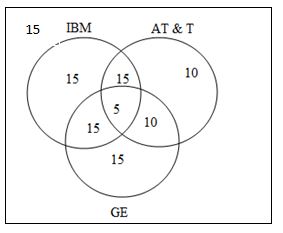
Concept explainers
Analyzing Survey Data In a survey of 100 investors in the stock market,
50 owned shares in IBM
40 owned shares in AT&T
45 owned shares in GE
20 owned shares in both IBM and GE
15 owned shares in both AT&T and GE
20 owned shares in both IBM and AT&T
a. How many of the investors surveyed did not have shares in any of the three companies?
b. How many owned just IBM shares?
c. How many owned just GE shares?
d. I low many owned neither IBM nor GE?
e. I low many owned either IBM or AT&T but no GE?
To find:
a. How many of the investors surveyed did not have shares in any of the three companies?
b. How many owned just IBM shares?
c. How many owned just GE shares?
d. How many owned neither IBM nor GE?
e. How many owned either IBM or AT&T but no GE?
Answer to Problem 29AYU
a. 15.
b. 15.
c. 15.
d. 25.
e. 40.
Explanation of Solution
Given:
In a survey of 100 investors in the stock market, 50 owned shares in IBM.
40 owned shares in AT&T.
45 owned shares in GE.
20 owned shares in both IBM and GE.
15 owned shares in both AT&T and GE.
20 owned shares in both IBM and AT&T.
5 owned shares in all three.
Formula used:
Calculation:
From the given data, we draw the venn diagram as shown below.

From the venn diagram,
a. Number of the investors surveyed did not have shares in any of the three companies is 15.
b. Number of investors who owned just IBM shares are 15.
c. Number of investors who owned just GE shares are 15.
d. Number of investors who owned neither IBM nor GE is .
e. Number of investors who owned either IBM or AT&T but no GE is .
Chapter 13 Solutions
Precalculus
Additional Math Textbook Solutions
Basic Business Statistics, Student Value Edition
Elementary Statistics: Picturing the World (7th Edition)
Calculus: Early Transcendentals (2nd Edition)
Thinking Mathematically (6th Edition)
A First Course in Probability (10th Edition)
- please do Q3arrow_forwardUse the properties of logarithms, given that In(2) = 0.6931 and In(3) = 1.0986, to approximate the logarithm. Use a calculator to confirm your approximations. (Round your answers to four decimal places.) (a) In(0.75) (b) In(24) (c) In(18) 1 (d) In ≈ 2 72arrow_forwardFind the indefinite integral. (Remember the constant of integration.) √tan(8x) tan(8x) sec²(8x) dxarrow_forward
- Find the indefinite integral by making a change of variables. (Remember the constant of integration.) √(x+4) 4)√6-x dxarrow_forwarda -> f(x) = f(x) = [x] show that whether f is continuous function or not(by using theorem) Muslim_mathsarrow_forwardUse Green's Theorem to evaluate F. dr, where F = (√+4y, 2x + √√) and C consists of the arc of the curve y = 4x - x² from (0,0) to (4,0) and the line segment from (4,0) to (0,0).arrow_forward
- Evaluate F. dr where F(x, y, z) = (2yz cos(xyz), 2xzcos(xyz), 2xy cos(xyz)) and C is the line π 1 1 segment starting at the point (8, ' and ending at the point (3, 2 3'6arrow_forwardCan you help me find the result of an integral + a 炉[メをメ +炉なarrow_forward2 a Can you help me find the result of an integral a 아 x² dxarrow_forward
 Calculus: Early TranscendentalsCalculusISBN:9781285741550Author:James StewartPublisher:Cengage Learning
Calculus: Early TranscendentalsCalculusISBN:9781285741550Author:James StewartPublisher:Cengage Learning Thomas' Calculus (14th Edition)CalculusISBN:9780134438986Author:Joel R. Hass, Christopher E. Heil, Maurice D. WeirPublisher:PEARSON
Thomas' Calculus (14th Edition)CalculusISBN:9780134438986Author:Joel R. Hass, Christopher E. Heil, Maurice D. WeirPublisher:PEARSON Calculus: Early Transcendentals (3rd Edition)CalculusISBN:9780134763644Author:William L. Briggs, Lyle Cochran, Bernard Gillett, Eric SchulzPublisher:PEARSON
Calculus: Early Transcendentals (3rd Edition)CalculusISBN:9780134763644Author:William L. Briggs, Lyle Cochran, Bernard Gillett, Eric SchulzPublisher:PEARSON Calculus: Early TranscendentalsCalculusISBN:9781319050740Author:Jon Rogawski, Colin Adams, Robert FranzosaPublisher:W. H. Freeman
Calculus: Early TranscendentalsCalculusISBN:9781319050740Author:Jon Rogawski, Colin Adams, Robert FranzosaPublisher:W. H. Freeman
 Calculus: Early Transcendental FunctionsCalculusISBN:9781337552516Author:Ron Larson, Bruce H. EdwardsPublisher:Cengage Learning
Calculus: Early Transcendental FunctionsCalculusISBN:9781337552516Author:Ron Larson, Bruce H. EdwardsPublisher:Cengage Learning





